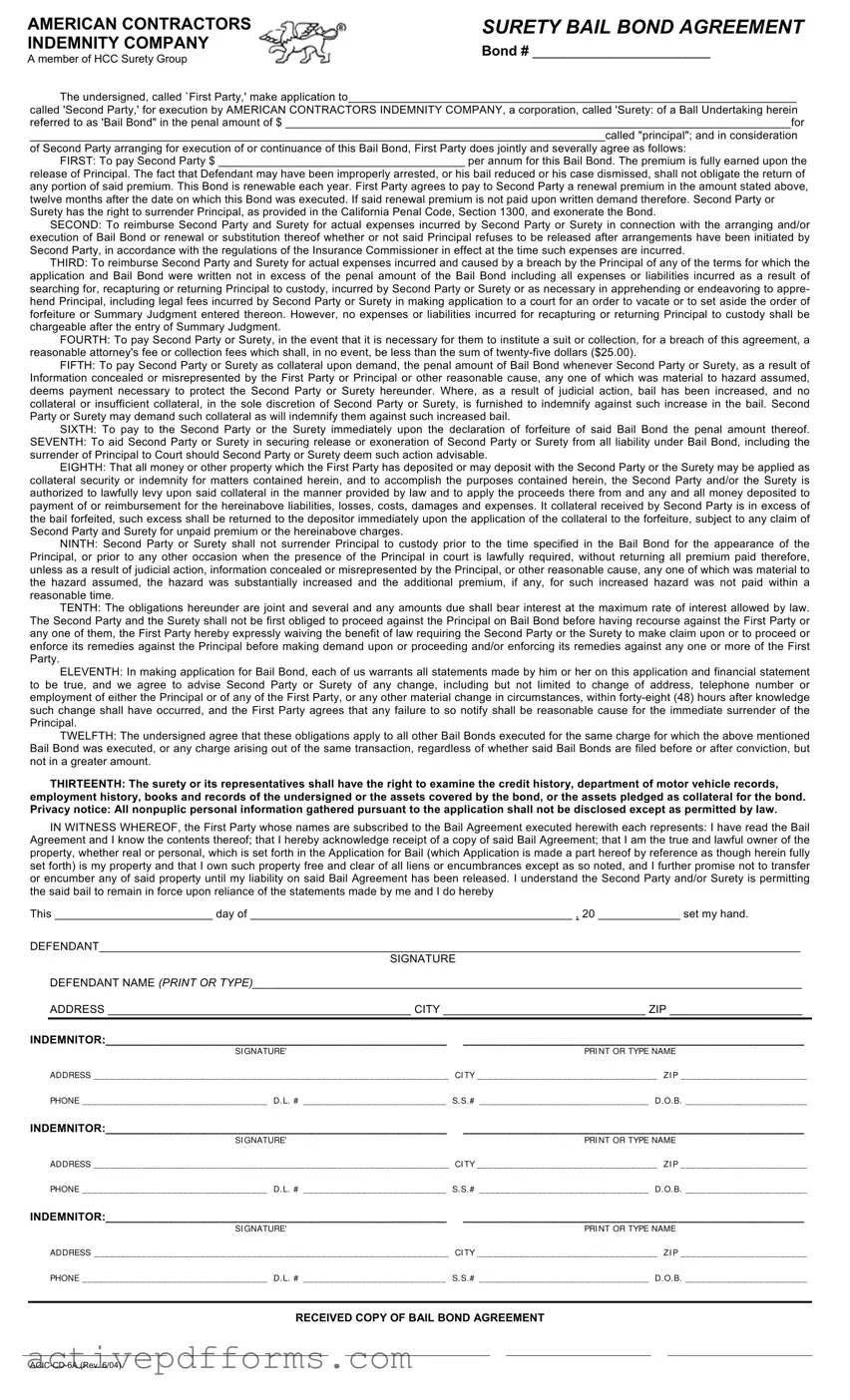|
AMERICAN CONTRACTORS |
SURETY BAIL BOND AGREEMENT |
|
INDEMNITY COMPANY |
Bond # _______________________ |
|
A member of HCC Surety Group |
|
|
The undersigned, called `First Party,' make application to_______________________________________________________________________
called 'Second Party,' for execution by AMERICAN CONTRACTORS INDEMNITY COMPANY, a corporation, called 'Surety: of a Ball Undertaking herein referred to as 'Bail Bond" in the penal amount of $ ________________________________________________________________________________for
___________________________________________________________________________________________called "principal"; and in consideration
of Second Party arranging for execution of or continuance of this Bail Bond, First Party does jointly and severally agree as follows:
FIRST: To pay Second Party $ _______________________________________ per annum for this Bail Bond. The premium is fully earned upon the
release of Principal. The fact that Defendant may have been improperly arrested, or his bail reduced or his case dismissed, shall not obligate the return of any portion of said premium. This Bond is renewable each year. First Party agrees to pay to Second Party a renewal premium in the amount stated above, twelve months after the date on which this Bond was executed. If said renewal premium is not paid upon written demand therefore. Second Party or Surety has the right to surrender Principal, as provided in the California Penal Code, Section 1300, and exonerate the Bond.
SECOND: To reimburse Second Party and Surety for actual expenses incurred by Second Party or Surety in connection with the arranging and/or execution of Bail Bond or renewal or substitution thereof whether or not said Principal refuses to be released after arrangements have been initiated by Second Party, in accordance with the regulations of the Insurance Commissioner in effect at the time such expenses are incurred.
THIRD: To reimburse Second Party and Surety for actual expenses incurred and caused by a breach by the Principal of any of the terms for which the application and Bail Bond were written not in excess of the penal amount of the Bail Bond including all expenses or liabilities incurred as a result of searching for, recapturing or returning Principal to custody, incurred by Second Party or Surety or as necessary in apprehending or endeavoring to appre- hend Principal, including legal fees incurred by Second Party or Surety in making application to a court for an order to vacate or to set aside the order of forfeiture or Summary Judgment entered thereon. However, no expenses or liabilities incurred for recapturing or returning Principal to custody shall be chargeable after the entry of Summary Judgment.
FOURTH: To pay Second Party or Surety, in the event that it is necessary for them to institute a suit or collection, for a breach of this agreement, a reasonable attorney's fee or collection fees which shall, in no event, be less than the sum of twenty-five dollars ($25.00).
FIFTH: To pay Second Party or Surety as collateral upon demand, the penal amount of Bail Bond whenever Second Party or Surety, as a result of Information concealed or misrepresented by the First Party or Principal or other reasonable cause, any one of which was material to hazard assumed, deems payment necessary to protect the Second Party or Surety hereunder. Where, as a result of judicial action, bail has been increased, and no collateral or insufficient collateral, in the sole discretion of Second Party or Surety, is furnished to indemnify against such increase in the bail. Second Party or Surety may demand such collateral as will indemnify them against such increased bail.
SIXTH: To pay to the Second Party or the Surety immediately upon the declaration of forfeiture of said Bail Bond the penal amount thereof. SEVENTH: To aid Second Party or Surety in securing release or exoneration of Second Party or Surety from all liability under Bail Bond, including the surrender of Principal to Court should Second Party or Surety deem such action advisable.
EIGHTH: That all money or other property which the First Party has deposited or may deposit with the Second Party or the Surety may be applied as collateral security or indemnity for matters contained herein, and to accomplish the purposes contained herein, the Second Party and/or the Surety is authorized to lawfully levy upon said collateral in the manner provided by law and to apply the proceeds there from and any and all money deposited to payment of or reimbursement for the hereinabove liabilities, losses, costs, damages and expenses. It collateral received by Second Party is in excess of the bail forfeited, such excess shall be returned to the depositor immediately upon the application of the collateral to the forfeiture, subject to any claim of Second Party and Surety for unpaid premium or the hereinabove charges.
NINTH: Second Party or Surety shall not surrender Principal to custody prior to the time specified in the Bail Bond for the appearance of the Principal, or prior to any other occasion when the presence of the Principal in court is lawfully required, without returning all premium paid therefore, unless as a result of judicial action, information concealed or misrepresented by the Principal, or other reasonable cause, any one of which was material to the hazard assumed, the hazard was substantially increased and the additional premium, if any, for such increased hazard was not paid within a reasonable time.
TENTH: The obligations hereunder are joint and several and any amounts due shall bear interest at the maximum rate of interest allowed by law. The Second Party and the Surety shall not be first obliged to proceed against the Principal on Bail Bond before having recourse against the First Party or any one of them, the First Party hereby expressly waiving the benefit of law requiring the Second Party or the Surety to make claim upon or to proceed or enforce its remedies against the Principal before making demand upon or proceeding and/or enforcing its remedies against any one or more of the First Party.
ELEVENTH: In making application for Bail Bond, each of us warrants all statements made by him or her on this application and financial statement to be true, and we agree to advise Second Party or Surety of any change, including but not limited to change of address, telephone number or employment of either the Principal or of any of the First Party, or any other material change in circumstances, within forty-eight (48) hours after knowledge such change shall have occurred, and the First Party agrees that any failure to so notify shall be reasonable cause for the immediate surrender of the Principal.
TWELFTH: The undersigned agree that these obligations apply to all other Bail Bonds executed for the same charge for which the above mentioned Bail Bond was executed, or any charge arising out of the same transaction, regardless of whether said Bail Bonds are filed before or after conviction, but not in a greater amount.
THIRTEENTH: The surety or its representatives shall have the right to examine the credit history, department of motor vehicle records, employment history, books and records of the undersigned or the assets covered by the bond, or the assets pledged as collateral for the bond. Privacy notice: All nonpuplic personal information gathered pursuant to the application shall not be disclosed except as permitted by law.
IN WITNESS WHEREOF, the First Party whose names are subscribed to the Bail Agreement executed herewith each represents: I have read the Bail Agreement and I know the contents thereof; that I hereby acknowledge receipt of a copy of said Bail Agreement; that I am the true and lawful owner of the property, whether real or personal, which is set forth in the Application for Bail (which Application is made a part hereof by reference as though herein fully set forth) is my property and that I own such property free and clear of all liens or encumbrances except as so noted, and I further promise not to transfer or encumber any of said property until my liability on said Bail Agreement has been released. I understand the Second Party and/or Surety is permitting the said bail to remain in force upon reliance of the statements made by me and I do hereby
This _________________________ day of ___________________________________________________ , 20 _____________ set my hand.
DEFENDANT_______________________________________________________________________________________________________________
SIGNATURE
DEFENDANT NAME (PRINT OR TYPE)_______________________________________________________________________________________
ADDRESS ________________________________________________ CITY ________________________________ ZIP _____________________
INDEMNITOR:______________________________________________________ |
______________________________________________________ |
SI GNATURE' |
PRI NT OR TYPE NAME |
ADDRESS _ _ _ _ _ ___ _ __ __ _ __ __ __ _ ___ _ __ __ _ __ __ __ _ ___ _ __ __ _ __ __ __ _ ___ _ __ __ _ __ __ _ |
CI TY _ __ _ __ __ __ _ __ __ _ __ __ _ __ __ __ _ ___ _ __ ZI P _ __ _ __ __ _ __ __ _ __ __ __ _ ___ |
PHONE _ _ _ __ __ __ __ _ __ __ _ __ __ __ _ ___ _ __ __ _ __ D. L. # _ _ __ __ _ __ __ __ _ ___ _ __ __ _ __ __ |
S. S. # _ _ __ __ _ __ __ __ __ _ __ __ _ __ __ __ _ ___ _ D. O. B. __ __ __ __ _ __ __ _ __ __ __ _ __ |
INDEMNITOR:______________________________________________________ |
______________________________________________________ |
SI GNATURE' |
PRI NT OR TYPE NAME |
ADDRESS _ _ _ _ _ ___ _ __ __ _ __ __ __ _ ___ _ __ __ _ __ __ __ _ ___ _ __ __ _ __ __ __ _ ___ _ __ __ _ __ __ _ |
CI TY _ __ _ __ __ __ _ __ __ _ __ __ _ __ __ __ _ ___ _ __ ZI P _ __ _ __ __ _ __ __ _ __ __ __ _ ___ |
PHONE _ _ _ __ __ __ __ _ __ __ _ __ __ __ _ ___ _ __ __ _ __ D. L. # _ _ __ __ _ __ __ __ _ ___ _ __ __ _ __ __ |
S. S. # _ _ __ __ _ __ __ __ __ _ __ __ _ __ __ __ _ ___ _ D. O. B. __ __ __ __ _ __ __ _ __ __ __ _ __ |
INDEMNITOR:______________________________________________________ |
______________________________________________________ |
SI GNATURE' |
PRI NT OR TYPE NAME |
ADDRESS _ _ _ _ _ ___ _ __ __ _ __ __ __ _ ___ _ __ __ _ __ __ __ _ ___ _ __ __ _ __ __ __ _ ___ _ __ __ _ __ __ _ |
CI TY _ __ _ __ __ __ _ __ __ _ __ __ _ __ __ __ _ ___ _ __ ZI P _ __ _ __ __ _ __ __ _ __ __ __ _ ___ |
PHONE _ _ _ __ __ __ __ _ __ __ _ __ __ __ _ ___ _ __ __ _ __ D. L. # _ _ __ __ _ __ __ __ _ ___ _ __ __ _ __ __ |
S. S. # _ _ __ __ _ __ __ __ __ _ __ __ _ __ __ __ _ ___ _ D. O. B. __ __ __ __ _ __ __ _ __ __ __ _ __ |
RECEIVED COPY OF BAIL BOND AGREEMENT

